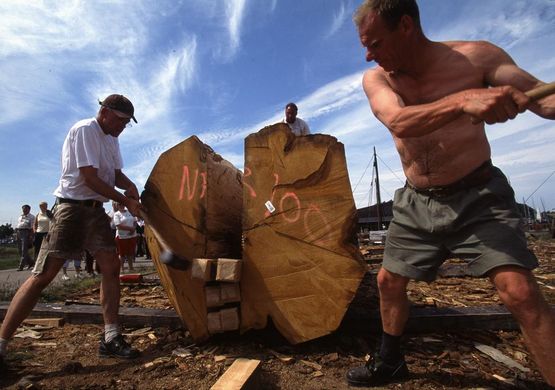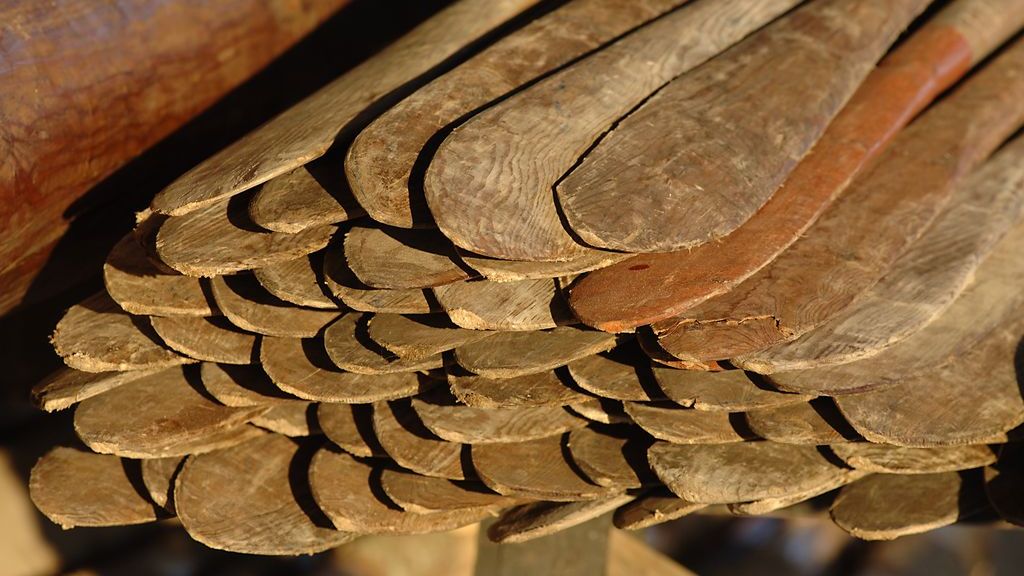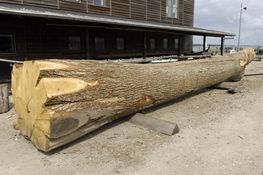You’ll need the biggest scales you can find, if you want to know the exact weight of the two massive oak logs that will be delivered to the Viking Ship Museum’s boatyard at around midday on Friday 1st September.
The two mature oaks will be used for the construction of a full-scale Viking ship, a reconstruction of Skuldelev 3 – a small trading ship from the year 1040, which was found near Skuldelev in Roskilde Fjord over 50 years ago.
The largest of the two logs is more than 10m long and has a diameter of 1m at ‘chest height’ as the boatbuilders say, when they describe timber to each other. In lay man terms, this means that it’s 1m in diameter ca. 1.5m from the point where the log was felled.
“How much do they weigh?…6 – 6.5 tons. There’s 6.5 cubic meters of material in the largest of them”, tells Martin Dael, team co-ordinator at the Viking Ship Museum’s boatyard. “One is 10.4m long and the other is just over 8m”.
At the boatyard, the logs will be cleaved into halves, then quarters, eights and sixteenths using mallets, wedges and raw muscle power. The boatbuilders will then use axes to hew these cleaved sections down to smooth, flexible and strong planks for the ship’s hull.
On Wednesday 6th September, the first of the logs will be cleaved. It’s an exciting process to witness, as the boatbuilders first use small wedges to create a small split in the root end of the log and then slowly – with larger and larger wedges and heavy blows from their mallets – work the split deeper into the log, forcing the fibres to split until the massive log eventually splits in two.
Afterwards, each half is then split again to quarters, which are then cleaved down to eighths and sixteenths until the whole log is divided into triangular sections, ready to be hewn down to ship’s planks – or boards, as they’re called once they’re mounted on the hull.
Info:
- The boatbuilders expect that the two logs will provide enough material for planking up to and including the sixth strake.
- All in all, there will be eight strakes – in other words, eight rows of planking – in the ship.
- When this year’s building season ends in the autumn, they hope to be finished with the second strake.
- Four pieces of crooked timber are also included in the delivery on Friday, and will be used to produce floor timbers – an element in the ship’s framing system.
- Construction of the ship began on 1st May 2017 and can be followed at the Viking Ship Museum for the next three years until the expected launch in 2019, where the Viking Ship Museum can celebrate its 50th year.
Info about the Skuldelev 3-project:
The Skuldelev 3 ship-find was excavated in 1962 near Skuldelev on Roskilde Fjord. Skuldelev 3 was found together with four other Viking ships – the so-called Skuldelev ships – all of which are on display at the Viking Ship Museum in Roskilde.
The five ships date to the late Viking Age, around the year 1040.
The Skuldelev ships were intentionally scuttled across a sailing channel leading to the important trading town of Roskilde, to prevent attack from enemy ships.
In 1982-84, the Viking Ship Museum began the first reconstruction of Skuldelev 3, but after more than 30 years of service, it’s no longer seaworthy.
During the last 30 years, the Viking Ship Museum has built reconstructions of all five of the Skuldelev ships. These reconstructions can be seen at the Viking Ship Museum – when they’re not out sailing on voyages!
The building of the new reconstruction began on May 1st 2017 and can be followed at the Viking Ship Museum for the next three years until the expected launch in 2019, where the Viking Ship Museum can also celebrate its 50th year.




